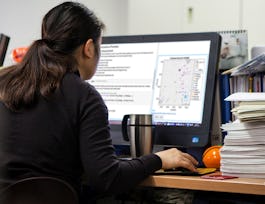This course continues your study of calculus by focusing on the applications of integration. The applications in this section have many common features. First, each is an example of a quantity that is computed by evaluating a definite integral. Second, the formula for that application is derived from Riemann sums.



Calculus through Data & Modelling: Integration Applications
This course is part of Integral Calculus through Data and Modeling Specialization

Instructor: Joseph W. Cutrone, PhD
Top Instructor
Sponsored by Barbados NTI
1,642 already enrolled
(20 reviews)
Recommended experience
Skills you'll gain
Details to know

Add to your LinkedIn profile
5 assignments
See how employees at top companies are mastering in-demand skills

Build your subject-matter expertise
- Learn new concepts from industry experts
- Gain a foundational understanding of a subject or tool
- Develop job-relevant skills with hands-on projects
- Earn a shareable career certificate


Earn a career certificate
Add this credential to your LinkedIn profile, resume, or CV
Share it on social media and in your performance review

There are 4 modules in this course
In this module, we generalize the notion of the average value of a (finite) set of points. Did you ever wonder how we compute the average temperature during the day if infinitely many temperature readings are possible? Or how the average rainfall is calculated? The notions in this module will allow us to expand the idea of an average value to compute averages with (infinite) values over a continuous interval.
What's included
1 video1 reading1 assignment
What do we mean by the arc length of a curve? We might think of fitting a piece of string to the curve and then measuring the string against a ruler. But this is difficult to do when working with a complicated curve. In this module we develop the precise notion of the length and curvature of an arc of a curve in both the xy plane and in space.
What's included
3 videos1 reading1 assignment
In this module, we show how the ideas of tangent and normal vectors can be used in physics to study the motion of an object, including its velocity and acceleration, but now we focus on curves in three dimensional space. The techniques developed here then allow us to study the rates of change for more advanced functions.
What's included
1 video2 readings1 assignment
Finding the area between two curves is not just an interesting application of definite integrals from a geometric view, but when working with the appropriate functions, has applications in economics, business, and even medicine.
What's included
3 videos1 reading2 assignments
Instructor

Offered by
Why people choose Coursera for their career




Learner reviews
20 reviews
- 5 stars
90.47%
- 4 stars
0%
- 3 stars
0%
- 2 stars
4.76%
- 1 star
4.76%
Showing 3 of 20
Reviewed on May 23, 2024
Excellent Module in Integration Applications. It provides a good introduction to Differential Geometry through specific topics of Newtonian Physics.
Recommended if you're interested in Math and Logic

Johns Hopkins University

University of Pennsylvania

Coursera Instructor Network

Open new doors with Coursera Plus
Unlimited access to 10,000+ world-class courses, hands-on projects, and job-ready certificate programs - all included in your subscription
Advance your career with an online degree
Earn a degree from world-class universities - 100% online
Join over 3,400 global companies that choose Coursera for Business
Upskill your employees to excel in the digital economy



